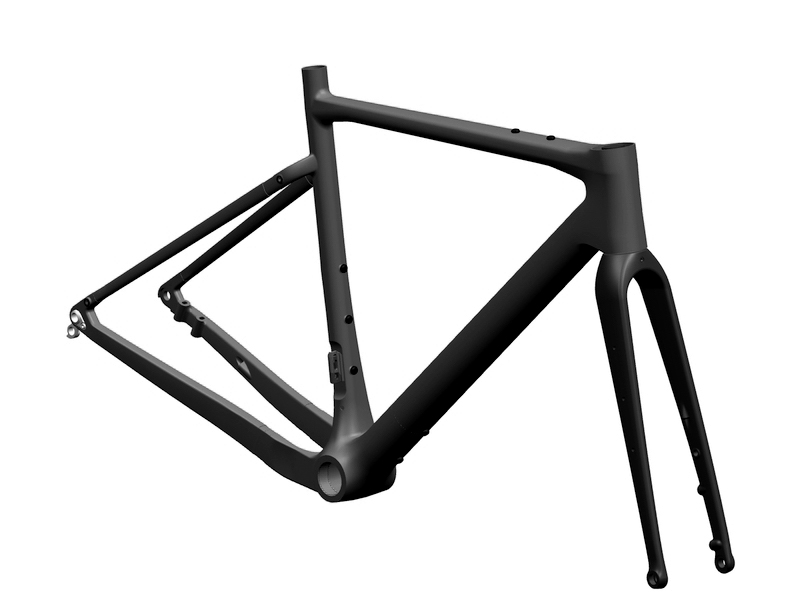Categories
New Blog
Tags
At first glance, it can be hard to tell the difference between a gravel bike frame and a cyclocross bike frame. Both share drop handlebars, knobbly tyres, rigid frames (in most cases) and wider tyre clearances than their road-going equivalents. So what are the differences?

Here, we analyse the key differences between gravel bikes frame and cyclocross bikes frame, look at what they're specifically designed for and consider which might be best for you and your off-road pursuits.
The best way to frame the differences between gravel and cyclocross bikes frame is to understand their purposes.
The best cyclocross bikes frame are dedicated to racing, designed for around an hour of flat-out speed and high-intensity riding. Manoeuvrability around tight, twisting 'cross courses is key, so cyclocross racers demand razor-sharp steering and, in many cases, an aggressive riding position.
Specific rules from the UCI, which governs professional racing, also dictate how cyclocross bikes frame are built. For now, at least, gravel bikes frame are not subject to any UCI rules like this.
For example, riders competing in UCI-sanctioned cyclocross racing must have tyres no wider than 33mm, so cyclocross race bikes rarely offer much clearance beyond this. We'll cover tyre clearance in more detail later.
Unlike cyclocross bikes frame, gravel bikes frame are typically designed for a range of purposes, from multi-day bike packing adventures to multi-terrain exploring closer to home, and even the burgeoning gravel racing scene.
As a result, gravel riding is a far-reaching discipline and, with gravel bikes used for a wide variety of riding, they tend to be less uniform in design than cyclocross bikes frame, although the best gravel bikes frame share some key features.
Before gravel bikes frame arrived on the scene, and with the advent of road disc brakes frame, some bike brands offered a cyclocross bike with a little extra versatility thrown in the mix, including mudguard and rack mounts.
However, with the dawn of gravel bikes frame and the inherent versatility they offer, many of the latest cyclocross bikes frame have become refocussed on CX racing frame.
Right, that's the basics covered, now let's take a closer look at the key differences between gravel bikes and cyclocross bikes, including geometry, tyres and tyre clearance, mounts, finishing kit and more.
Gravel vs cyclocross bike frame geometry
Most gravel bikes feature a more relaxed geometry than cyclocross bikes, designed for days of riding rather than an hour or so, and for tackling rougher trails.
This enhanced emphasis on comfort tends to give a shorter reach and more upright body position. Due to the reduced speeds that are typically involved with gravel riding, aerodynamics are less of a priority here.
But this depends on the category of gravel bike frame we're talking about: gravel race bikes, such as the BMC Kaius, are a notable exception.
The location of the bottom bracket in relation to the ground also differs between gravel and cyclocross bikes frame.
A lower bottom bracket (and hence centre of gravity) gives better stability over rougher terrain for gravel bikes, as well as reducing standover height, meaning it’s easier to dab or dismount on technical terrain.
A longer wheelbase for gravel bikes frame also has the effect of improving stability here, as well as on steep descents.
The higher bottom bracket of cyclocross bikes frame improves ground clearance for race obstacles. It also shifts the rider's weight towards the front of the bike, giving a more direct steering response.
Finally, you’ll often find slacker head tube angles on gravel bikes frame, more akin to mountain bikes frame than cyclocross bikes frame, which in turn are more similar to racy road bikes frame.
A slacker head tube angle improves off-road capability, so gravel bike frame geometry at the rowdier end of the spectrum will feature slacker angles (lower numbers), whereas racier models will feature steeper head tube angles.
Gravel vs cyclocross tyres and tyre clearance
Besides geometry, tyres and tyre clearance are the biggest differences between gravel and cyclocross bikes.
At pro-level racing, cyclocross tyres can measure no wider than 33mm, so cyclocross bikes typically have relatively narrow tyre clearances to accommodate these tyres, with some room for mud, too.
Cyclocross tyres range from super-aggressive treads for mud to file treads for bone-dry or summer 'cross, and tend to use softer compounds than gravel tyres because they’re designed for use on grass and mud rather than harder surfaces such as tarmac.
Cyclocross tyres often don’t have the same level of puncture protection as gravel tyres, and are designed to be lighter and more supple for racing.
Gravel bikes have wider tyre clearances than cyclocross bikes, often fitted with 40mm gravel tyres or bigger, and the latest frames often feature space for tyres measuring up to a couple of inches (around 50mm) wide.
These wider tyres are crucial not only for giving more comfort over longer rides, but also for allowing riders to tackle more technical terrain such as roots and rocks at a lower tyre pressure, thus reducing the risk of pinch-flats, especially with a tubeless tyre setup.
On that note, tubular tyres have long been popular with cyclocross riders, thanks to the reliability and flat protection offered by tubs. However, tubeless tyres are growing in popularity on the CX scene, too.